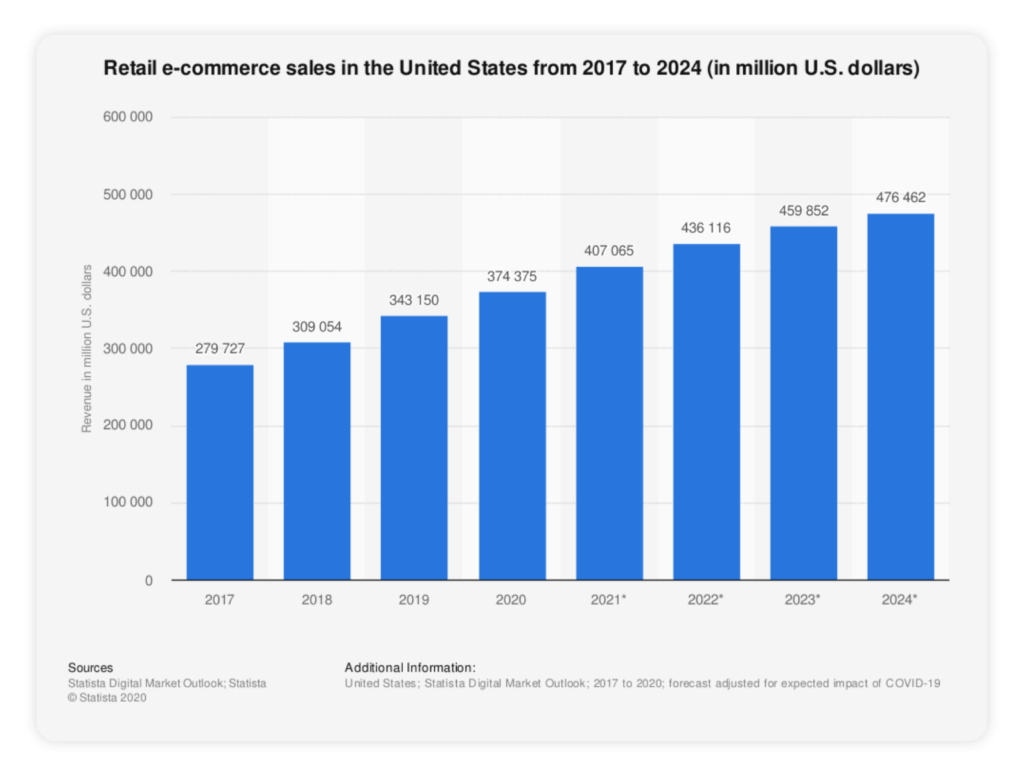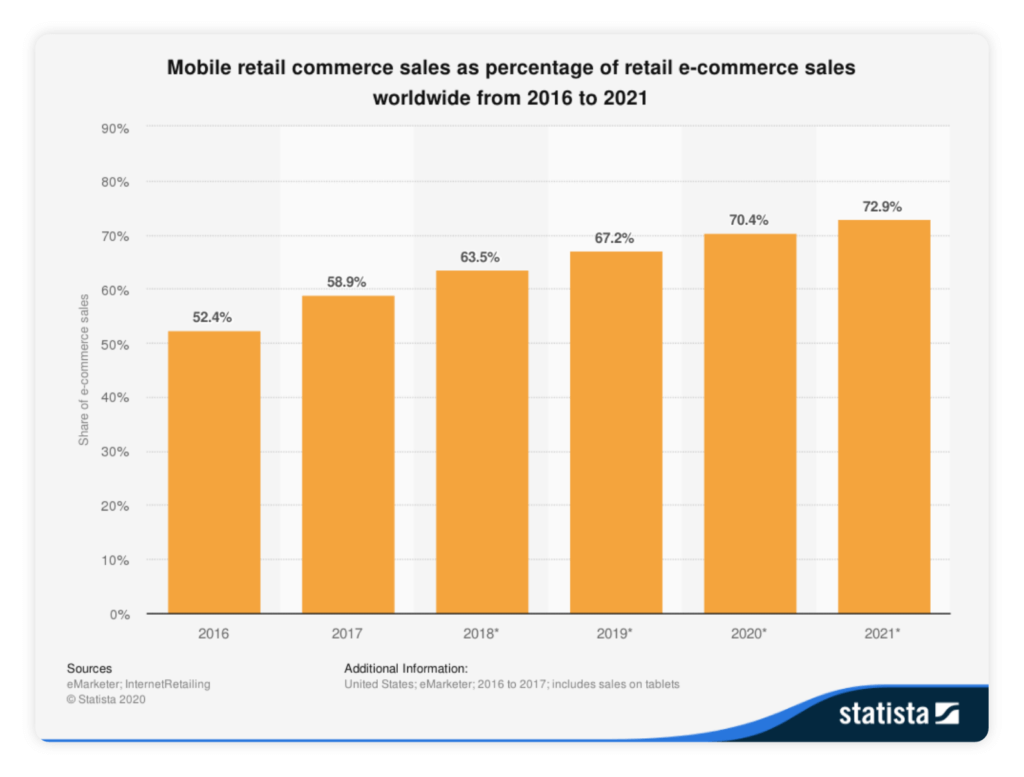
Digital Transformation and the Future of Ecommerce
Digital transformation isn't a trend or buzz phrase. It's the evolution of how business is conducted in the digital age.
We could start this article with a dry definition of digital transformation and why it’s essential to running a successful business in 2021, but that would be boring (and played-out at this point) – so we won’t. Instead, we’re going to make digital transformation relatable by telling you a true story.
Once upon a time, there was an artist. We’ll call him Joe. At the beginning of his career, Joe sold most of his oil paintings via galleries and paid a 50% commission for the privilege. He built up an enthusiastic fan base in the Midwest and brought in a healthy income, even as gallery attendance fell.
Years later, Joe and his family made an international move. They found a home in a remote, beautiful area on the edge of the ocean, and Joe began to paint a totally new landscape. He formed partnerships with two local galleries and waited for summer to begin.
Then, COVID-19 struck. No more galleries; no more tourist season. To stay afloat, Joe had to convert his business from a gallery-centric enterprise into a B2C ecommerce venture overnight. In short, the time for Joe’s digital transformation had come.
We’ll revisit Joe’s art business later. First, let’s talk about why digital transformation matters and how you can make it a key part of your business plan.
Here’s what we’ll be covering in this article:
- What are the driving forces behind digital transformation?
- How will digital transformation impact the future of ecommerce?
What are the driving forces behind digital transformation?
Before we dive too deep into this topic, I think it’s valid that we first answer the question: what is digital transformation? Let’s take the wool out of the wooliest phrase in ecommerce with a simple definition: every time you abandon a physical process in favor of a digital process, you engage in a digital transformation strategy. In simple terms, setting aside pen and paper in favor of a note-taking app is a form of digital transformation.
Other examples of digital transformation include:
- Switching from mail flyers to email marketing.
- Adopting new technologies, like cloud computing.
- Using digital tools, like social media, to drive product engagement.
- Blending ecommerce with in-store pickup; BOPIS (Buy Online Pickup In Store).
- Leveraging data to create targeted multi-channel marketing plans.
- Partnering with research and market intelligence companies, like Gartner, IDC, and McKinsey, to hone digital business strategy.
- Embracing digital change.
Digital transformation isn’t jargon extracted from a pretentious keynote speech: it’s an essential part of staying in business. Retailers used to battle it out on the high street, while wholesalers sent out paper catalogs. Now, B2B and B2C companies compete against their rivals online. Business leaders all want a slice of the ecommerce pie, and companies who don’t keep up quickly go bust.
So, what are the driving forces behind digital transformation?
1. Shoppers are looking for new products online.
According to CRM company Salesforce, a staggering 87% of shoppers look for product information and helpful reviews online — even if they plan to make their final purchases in a brick-and-mortar store. Consumers expect to find up-to-date information and brand contact information quickly and easily.
2. Customer expectations continue to rise.
Modern consumers are discerning and expect personalized experiences across a range of channels. Maybe you’ve heard of omnichannel marketing? People expect their shopping baskets to travel from device to device, and they enjoy using apps. If you want to grow your bottom line, you need to cater to your customer base.
3. Brands need a strong online presence to show value.
A growing number of brands now choose direct-to-consumer, rather than wholesale marketing strategies. The benefits go both ways: companies cut out the middleman and make more profit, and consumers get to communicate directly with brand manufacturers. Robust branding and a strong online presence create a roadmap for success in that type of marketplace.
How will digital transformation impact the future of ecommerce?
As an ecommerce retailer or business-to-business wholesaler, you already have a firm grip on the digital world. So you’re done, right? Wrong. Digital transformation doesn’t have an endpoint. There won’t be a moment where you sit back, dust off your hands, and say, “Right — that’s it.”
Your website is only one aspect of your company’s digital transformation. You also need to keep track of shifts in consumer expectations and behaviors, so you can modify your tactics to meet the needs of your customer demographic. Finally, you have to keep up with your competitors. If they offer free shipping, you offer free shipping; if they have a BOGO weekend, go one better.
Many entrepreneurs feel intimidated by digital transformation. Instead of worrying, try to approach change management with a sense of adventure and opportunity. After all, when companies invest in logical new business processes, they usually reap major rewards. Let’s take a look at nine ways digital transformation will change ecommerce in the coming months and years.
Enjoying this article?
Subscribe to our newsletter, Good Question, to get insights like this sent straight to your inbox every week.
1. Direct-to-consumer (DTC) and private-label selling accelerates.
We wrote a little about direct-to-consumer (DTC) earlier; now, we’ll dive in deeper. Until recently, most brands (especially new brands) built partnerships with major brick-and-mortar retail outlets. Because they made wholesale deals, brand manufacturers missed out on significant profits. Meanwhile, their retail partners increasingly developed private-label versions of branded products.
DTC business strategy is as much a reaction to the rise of private label products as it is a desire to make more money. When brands adopt a direct-to-consumer approach, they reap more than extra cash — they also get to know their customers better. When they bypass their retail partners and choose DTC ecommerce instead, manufacturers also offset sluggish in-store sales.
Let’s dig deeper into some of the additional benefits of a DTC strategy.
Brands gain a better understanding of their consumer bases.
When brand manufacturers make wholesale deals with retailers, they give up direct contact with consumers. From that moment onward, they’re reliant on post-sale surveys, voluntary consumer feedback, and reviews to understand their product’s end users.
When they switch to a DTC approach, businesses recoup that consumer connection. Customers communicate directly with brand manufacturers; brand manufacturers respond quickly and offer effective support. Companies who adopt DTC also regain the ability to harvest consumer data so that they can learn more about their followers.
DTC provides a unique customer experience.
According to a survey by iXtenso magazine, more than 55% of shoppers want to buy directly from brand manufacturers. They want a personalized experience, including custom packaging, mix-and-match product assortments, and seasonal exclusives, which all head the must-have list.
Brand manufacturers who use omnichannel marketing to deliver a seamless experience across devices make more sales than those who don’t. Companies who go with DTC control their customer’s experiences from start to finish, so they have tremendous power to improve consumer satisfaction.
Build brand relationships with customers.
When companies sell merchandise directly to consumers, they build a generation of brand evangelists who go out and tell others about their favorite products. Consumers who feel loyalty to a particular brand tend to stick with that brand for years — they become valuable assets, thus increasing your customer retention rate.
Brands that develop deep customer relationships inevitably do better in the long term. You don’t have to wait to build a brand relationship, either. Water bottle manufacturer Larq began its DTC strategy long before launch; the result was an overwhelmingly successful start-up crowdfunding campaign and a loyal consumer base from the get-go.

2. Augmented reality breaks down the limitations of online shopping.
Let’s revisit our artist friend, Joe, for a moment. Joe has to convince collectors who’ve never seen his art in person that it is high quality and worth hundreds or even thousands of dollars apiece. He has to make his paintings as real as possible so people can imagine his creations hanging in their homes. He can do this by installing augmented reality (AR) software apps on his website.
AR software is a game-changer in the ecommerce industry because it helps shoppers visualize the products that interest them. Before AR, consumers were reliant upon their imaginations, tape measures, and luck. They weren’t able to envision products confidently. AR integrations revolutionized ecommerce by removing that major psychological barrier to purchase.
If you want to see AR in action, look no further than furniture retailer Burrow. Burrow has an app called Burrow at Home, which consumers can use to try out furniture items in their living spaces virtually. Using the app, they scan the floor of a room, customize their Burrow sofa, and drop it into view.
SaaS ecommerce platforms like BigCommerce work with a range of AR integrations. One example, LIVEb4buy, lets ecommerce retailers create 360-degree panoramic spaces (the inside of physical stores, demo spaces with furniture in them, and so on). Consumers “walk” around these spaces and select products to learn more about them.
3. More physical retail businesses shifting to ecommerce as a primary revenue stream.
Joe’s world changed when coronavirus arrived — and most other retailers felt a similar seismic shift. When the pandemic hit full force, consumers in lockdown turned to the internet for almost everything. When stores ran out of toilet paper, they stockpiled all the Charmin on Amazon. When grocery stores got too scary, they bought essentials online. Some ecommerce outlets ran out of stock. Others imposed purchase limits.
By mid-April, online retailers in the U.S. had experienced year-on-year revenue growth of 68%. By the end of June, the initial rush had subsided, but sales were still up more than 41% over 2019. By August, industry pundits began to speculate that consumer spending habits had shifted permanently. Brick-and-mortar stores, it seemed, had been usurped by ecommerce websites.
When brick-and-mortar retailers and wholesalers shut their doors during the COVID-19 pandemic, they suffered considerably. Ecommerce retailers found themselves living in Boomtown, but behind the scenes, long-established packing and shipping processes crumbled as social distancing led to a reduction in warehouse staff. Couriers were overwhelmed with packages, and shipping times increased considerably.
Panic buying eventually diminished, leaving retailers to sift through the rubble. Businesses without websites swiftly set up online stores, while those with existing ecommerce outlets improved workflows and warehousing solutions to prepare in advance for future mayhem. Newly abandoned stores in towns all over the country broadcast the abrupt death knell of High Street domination.
Ecommerce had been slated for victory long before the pandemic. Now, economists project that by 2024, retail ecommerce sales will top 476.5 billion dollars — up from 279.7 billion dollars in 2017. Far from a catchphrase, digital transformation is an essential process for brick-and-mortar businesses in the modern world.

4. Big data will play a significant role in enhancing personalization.
Big data is big business, and it’s a big part of digital business transformation. Huge ecommerce retailers like Amazon use big data to provide consumers with highly personalized shopping experiences. How do they make this magic happen? By using machine learning to modify site algorithms based on previous consumer activity. Like friendly neighborhood barbers, online giants recognize that familiarity boosts the bottom line.
How much big data is too much big data? Well, some customers love being “known,” while others prefer to remain anonymous. When companies track their customers using internal data, they learn more about them. On one hand, that’s savvy sleuthing. On the other hand, some industry pundits and privacy experts worry about consumer privacy.
In the future, it may be easier for people to opt-out of personalization. For now, companies continue to push personalization in Internet of Things (IoT) devices, like thermostats, doorbells, and artificial intelligence (AI) tech (think Amazon Alexa or Siri). If you want to make big data and personalization part of your new business model, you can install product recommendation integrations on your site.
5. Headless and API-driven ecommerce allow continued innovation.
Most people have no idea how their favorite sites work. They hop online at lunchtime, visit Larq, order a Midnight Rendezvous gift set, and go back to work. Behind the scenes — and faster than the speed of sound — their order preferences travel through Larq’s headless commerce system and file neatly into its database.
Companies like Larq know that headless ecommerce is the only way to go. In a nutshell, headless ecommerce decouples a company’s ecommerce platform from its frontend. When uncoupled, any data entered into Larq’s backend travels seamlessly to a range of frontends via application programming interfaces (APIs) — for example, progressive web apps (PWAs) and content management systems (CMSs).
To leverage headless commerce, companies add content to a compatible backend and couple on APIs — a custom frontend (Larq used React) and a smartphone app, for example. If that sounds complex, don’t fret. Many ecommerce platforms, including SaaS options like BigCommerce, make headless commerce easy.
Here are a couple of additional reasons why headless commerce makes sense:
- Flexibility: Headless commerce is SEO friendly, and it’s flexible and agile across a range of devices. It also makes multi-region platforming simpler, enabling businesses to create one single domain for international transactions.
- Personalization and customization: Consumers expect to be able to pause shopping on one device and continue on another — sometimes at a much later time. Businesses can control the consumer experience from start to finish by using a headless commerce tech stack, streaming data from one central database to a collection of APIs.
6. Wide-spread adoption of alternative payment methods.
First invented in the 1920s (which is surprising, isn’t it), credit cards have had a century-long monopoly on consumer spending. In comparison, alternative payment methods, including blockchain platforms like Bitcoin, are the new kids on the block. They’re very popular, though — especially buy-now-pay-later (BNPL) services, which have a large following in the millennial demographic.
To stay ahead of the pack, contemporary ecommerce companies must offer their consumers a range of payment methods, including BNPL options. This aspect of digital transformation is especially important for luxury goods and apparel retailers, whose products frequently sit in the want-but-not-need niche. No room for a designer dress in an average consumer’s monthly budget? Add an interest-free monthly payment option and you may gain a new aficionado.
7. Mobile shopping continues to expand.
People buy all sorts of things on their smartphones. Earlier, we mentioned Burrow’s handy Burrow at Home app, which makes visualizing and buying a sofa much easier. Nobody likes digital disruption: modern websites have to look good — and work — on tablets, phones, and desktop computers. If you have a great responsive website, you may not need an app at all.
Bon Bon Bon’s adaptive website looks great on a small screen. Consumers browse candy on their laptops over breakfast, hop onto Bon Bon Bon’s site while on the train to work, and order boxes of chocolate via smartphone before they hit the office.

Recent data gathered by Statista predicts that by 2021, nearly 73% of ecommerce transactions will take place on mobile devices. Consumers nearly always have a choice of retailer or wholesaler — if you don’t offer them a fluid experience, they’ll simply shop elsewhere. Don’t let this aspect of digital transformation pass you buy.

8. Businesses will focus more on optimization.
Digital experience optimization, or DXO, is just as important as good SEO — in fact, many experts consider it an essential follow-on. SEO techniques drive traffic to your site, while DXO strategies convert visitors into customers. When businesses implement effective frameworks, they make existing Google and Bing leads more lucrative.
Optimization takes an iterative approach to optimization. Admins make website adjustments and then measure results to see if they’ve had a positive impact. Every change happens for a reason, and all changes are intended to improve the user experience. Subtle page design alterations, more compelling product descriptions, better navigation options, and simpler checkout processes all reduce friction and make purchases more likely.
When they use optimization to hone their sites, ecommerce retailers almost always see profits increase. Many decision-making CIOs (chief information officers) plow those profits right back into SEO, prompting more traffic followed by an even greater number of conversions.
9. B2B will become increasingly more prevalent.
An expanding market, B2B ecommerce will probably continue to grow for the foreseeable future. Combined manufacturing and merchant wholesale business-to-business ecommerce transactions grew nearly $4 trillion per annum between 2006 and 2018. Retail B2B is just as busy: according to Statista, business-to-business retail sales will probably top $1.1 trillion by 2021.
In the past, many B2B websites were clunky at best. Wrapped in templates that might have been cutting edge in 1998, some of the worst offenders went from relevant to obsolete. Customers sent supply chain orders via fax or phone, and online product catalogs were often woefully out of date.
Thanks to digitization initiatives, most modern B2B ecommerce sites offer visitors an intuitive, autonomous user experience. Clients place orders online, and B2B businesses build brand loyalty just like retail ecommerce stores.
Digital Transformation is an Ecommerce Revolution
Digital transformation isn’t a trend or a buzz phrase: it’s a revolution in a digital age. In 2012, electronics retailer Best Buy stood on its last legs, its stocks in ruins. Traders dismissed the corporation as a dead duck, and members of its own board called the company a lost cause. In the end, they were all wrong: Best Buy survived and regained its stock value — and then some. How? A new CEO and a fresh digital technology vision.
Sole traders like Joe the artist, small businesses, medium-sized B2B merchants, and large corporations all benefit when they take digitization seriously. If you’re ready to make digital transformation part of your business plan, try implementing some of the tactics in this article. You might be surprised at your own success.
Enjoying this article?
Subscribe to our newsletter, Good Question, to get insights like this sent straight to your inbox every week.

About the Author
BigCommerce
BigCommerce is a public technology company and provides a SaaS ecommerce platform. Its features include customer groups and segmentation, search engine optimization, web hosting, and more.